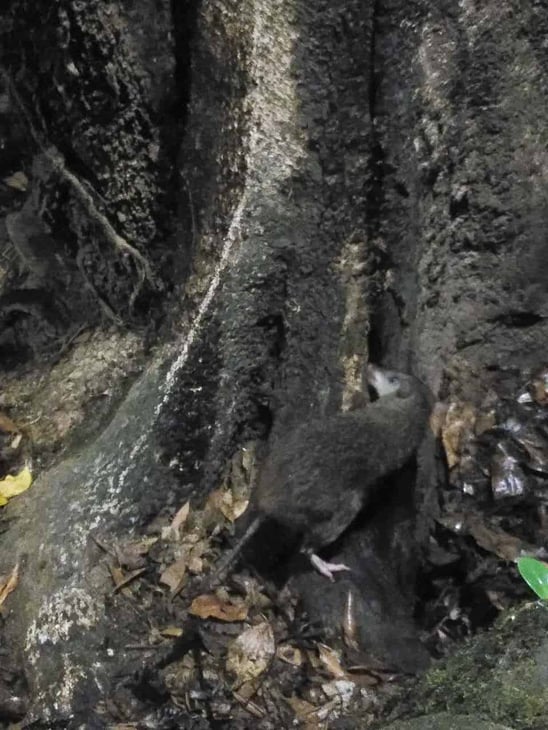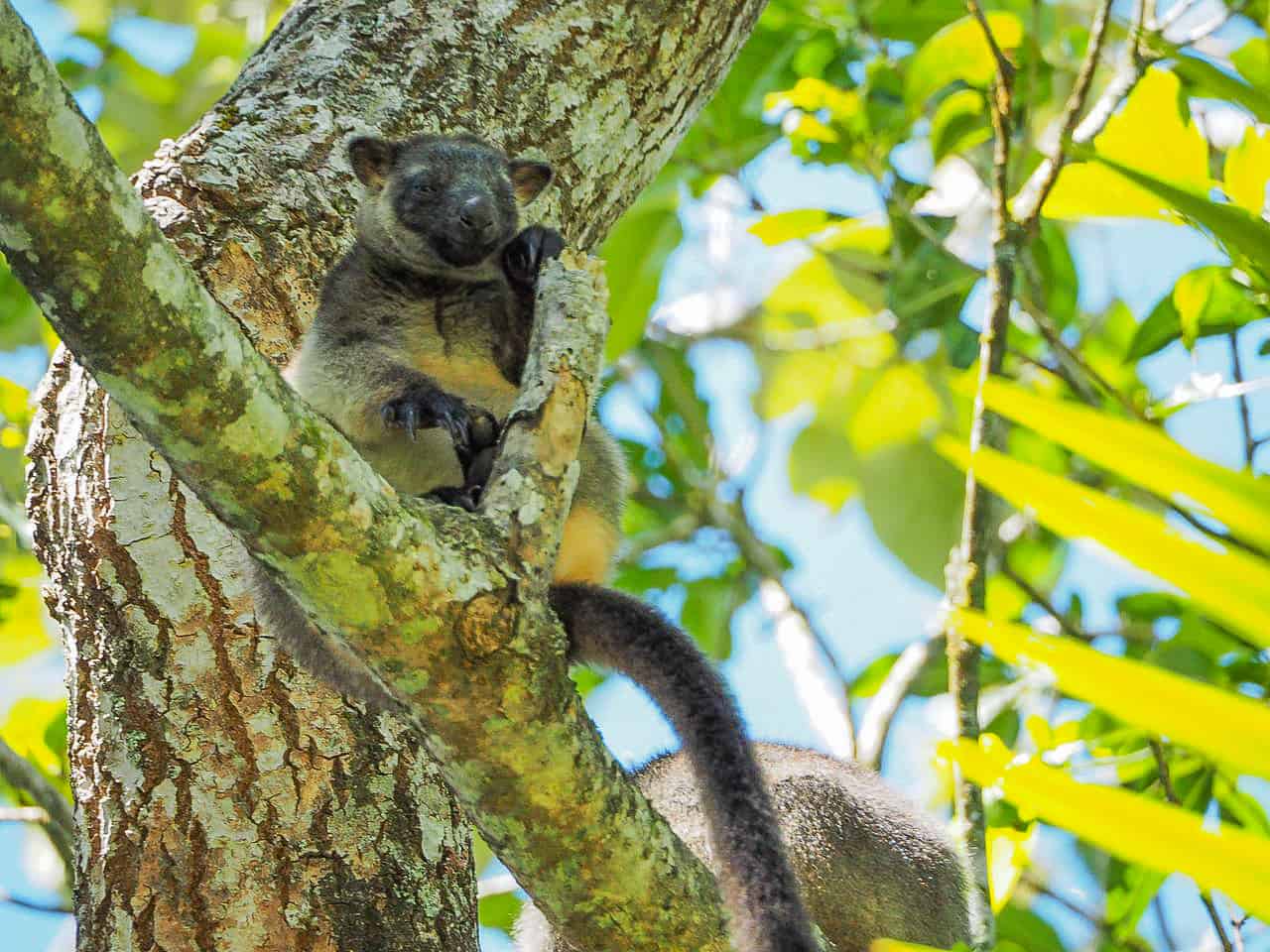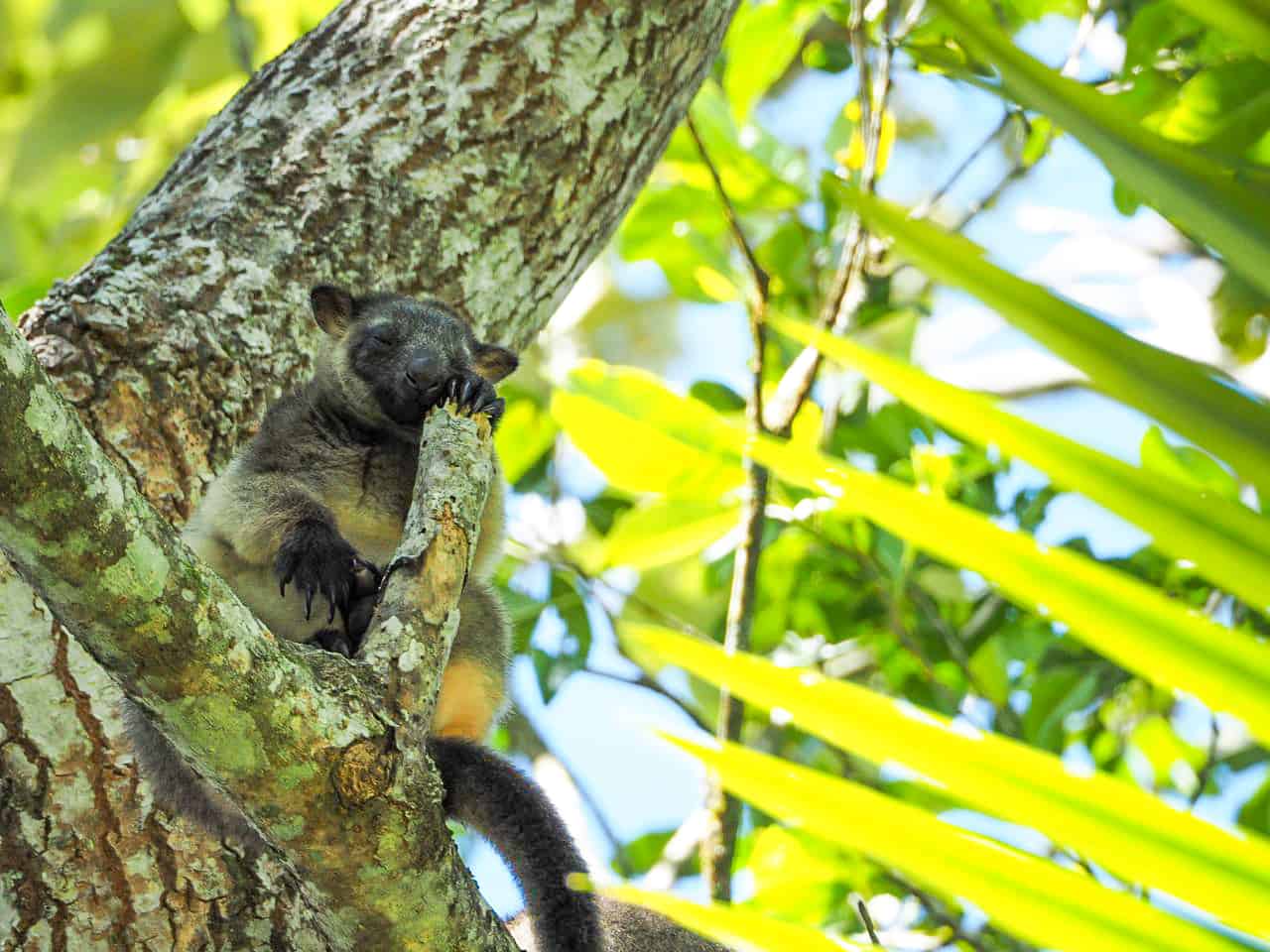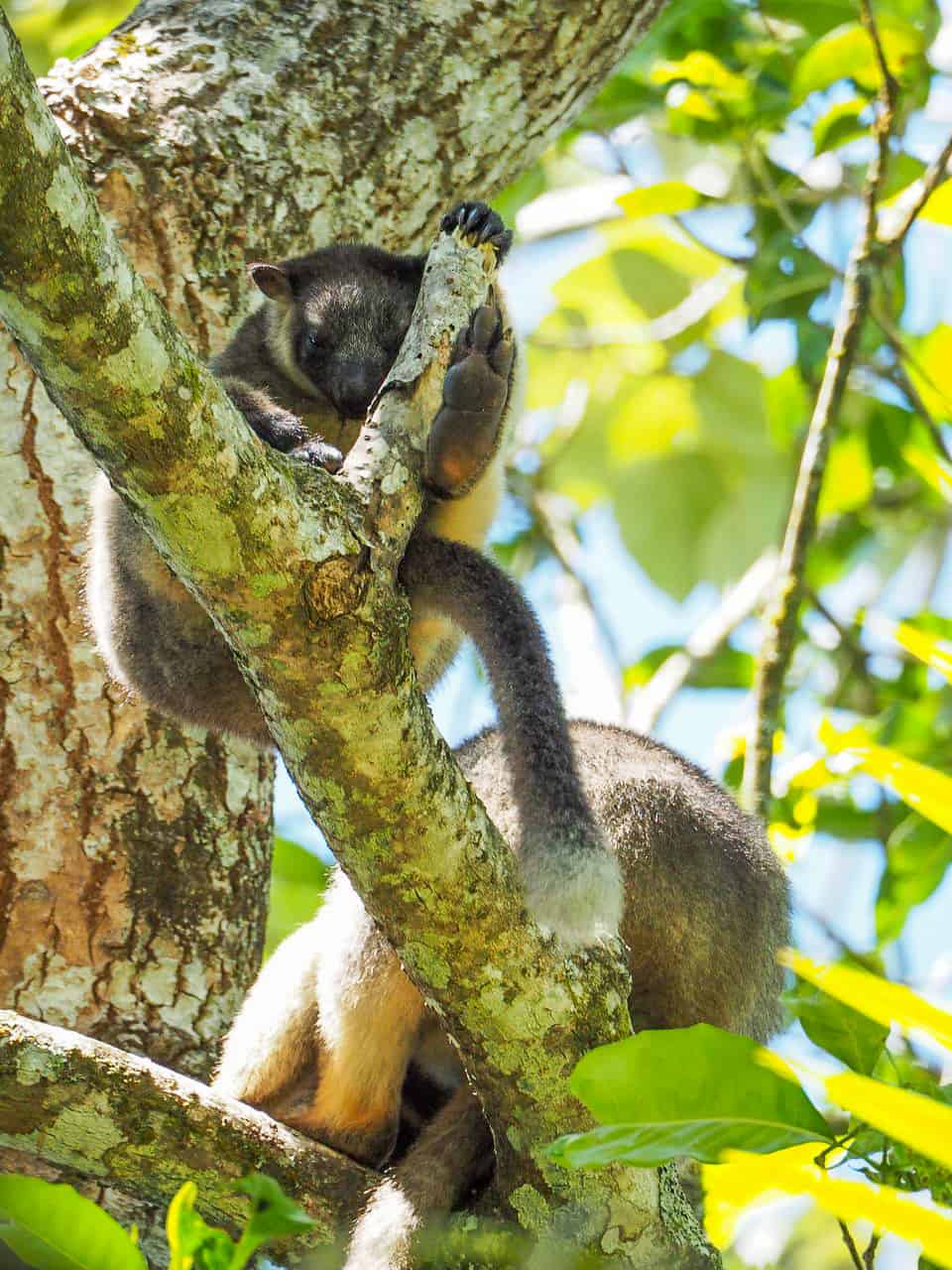Before our 12-day adventure in the Atherton Tablelands, I’ve often joked with the Sailor about how well visitors are informed about the presence of local wildlife on information boards etc, but that you never actually see anything! It wasn’t until we camped at Lake Tinaroo that we discovered why.
Whilst the region is a biodiverse hotspot with the highest number of endemic mammals compared to anywhere else in Australia, most of them are nocturnal and/or shy so you have to use your smarts to find them. Guys, I’m here to help you out!

When you start looking in the right places, the variety of wildlife in the Atherton Tablelands is incredible. Not only did I see species I had no idea existed, but some are totally unique to this region…and there’s still plenty I haven’t found yet.
In this guide, I’ll reveal the locations I sighted some unique animals on our trip for you to get those warm, fuzzy feelings too.
Good luck! 🍀

But first, a few tips…
◇ As most of these animals are nocturnal, you may want to consider camping overnight or staying at a wildlife lodge to better your chances. You’ll literally have some species walking around you in places like Lake Tinaroo which was a real highlight experience for us. Check out my top places to stay here.
◇ If you’re short on time or fancy a pro with you, then you may also prefer to head out with an experienced guide on a night tour. Not only will they know what to look out for but they’ll be aware of how to minimise human impact on the animals. Click to find out more.
◇ If you’re staying overnight but aren’t on a tour, then you’ll need a torch handy. Although do be aware that nocturnal animals have very light-sensitive eyes, so try not to shine the light directly on them to prevent them becoming distressed.
◇ Of course, like any wild animals, sightings aren’t guaranteed. But make sure you have your best Jane Goodall head on today!
Places to Spot Unique Wildlife in the Atherton Tablelands
1. Mareeba Rock Wallabies

Granite Gorge is a habitat native to a small colony of endangered Rock Wallabies. They were identified as a new rare species at the Gorge in 1996 so this is the only place you can see them in Australia.
We stayed here for our first two nights in the Tablelands which was the perfect start to our trip.
![Granite-Gorge-Wallabies-Atherton-Tablelands-North-Queensland-Australia ] Travel Mermaid 178](https://imagedelivery.net/XCDGdz-tcjvcKISD7dR0PQ/travelmermaid.com/2020/01/Granite-Gorge-Wallabies-Atherton-Tablelands-North-Queensland-Australia-Travel-Mermaid-178.jpg/w=9999)
These marsupials are generally very placid and easy-going, and enjoy a good feed when people come to visit.
You can buy them small pellets of food from reception (available for $1 a bag) and most will gently hold your hands to eat from it. I don’t normally condone feeding wildlife but these guys are a bit less ‘wild’ these days, and have become quite reliant on guests giving them sustenance.

Don’t worry if you’re not staying here as non-guests are welcome to enter the gorge for the day at a small fee. You can also check out their 1k – 3k walking track which I’d highly recommend. It’s an easy hike that traverses across huge granite boulders with the wallabies before leading you around a croc-free swimming hole, and it finishes up in the Savannah like wilderness.

As well as the wallabies, we spotted some other animals around our cabin like the green tree frog, possums and lizards. A beautiful peacock regularly come to sleep on our deck too, which must have been his favourite spot considering the poos he left when we arrived! 😁
The Gorge also has a range of other non-wild animals around reception which were a hit with visiting kids.
◇ If you’re considering staying here, check out my post to find out more details or head to the Granite Gorge website to book.
2. Northern Bettong
![Northern-Bettong-Queensland-Australia- photo by ::wettropics.gov.au ] Travel Mermaid-1](https://imagedelivery.net/XCDGdz-tcjvcKISD7dR0PQ/travelmermaid.com/2020/01/Northern-Bettong-Queensland-Australia-photo-by-wettropics.gov_.au-Travel-Mermaid-1.jpg/w=9999)
This is an animal I had no idea existed before our trip. Northern Bettongs are really cute, nocturnal marsupials that look more like rabbit-sized rats than kangaroos, hence their nickname ‘rat-kangaroos’.
They can only be found around this region as they’re quite fussy about where they live, preferring grassy woodland areas near tropical rainforests.
I saw quite a few of them at Camp Barrabadeen by Lake Tinaroo where we stayed for a couple of nights.

You’re likely to hear them rustling through the leaves on the forest floor before sighting them. Usually they’ll be hunting for things like fruits, seeds, tubers and fungi- including their favourite food, truffles! They have impeccable taste and are the biggest dispersers of truffles around here.
If primitive camping isn’t your style then I’m sure there’s definitely a few more rural places in the neighbourhood where they can be seen.
You can find out more about Northern Bettongs on the WWF website.
3. Platypus

Platypus are a bit of a freak of nature. Whilst being endemic to Eastern Australia, they’re one of only two mammals that lay eggs (the echidna is the other, also found in Australia).
With the bill and webbed-feet of a duck, the tail of a beaver and the body and fur of an otter, they’re fascinating to say the least. If you were a new explorer to Australia, you’d probably think you were hallucinating! In fact, many did and deemed early specimens as fake.
But even more unlikely is that they’re one of only a few species of mammals that are venomous. Males can provide a toxic blow from their rear feet using sharp stingers so lethal, that you’d be left in excruciating pain and may be incapacitated.
Yet another reminder that lethal animals are all over Australia, even in the cutest form!

We spotted platypus in a couple of places in the Tablelands.
The best place to view them in their natural habitat is at the Australian Platypus Park. Whilst they’re known for being more active at dawn and dusk, you’ll definitely see loads here during the day. The area is really peaceful and lush too.
We spent an hour by the lake and sighted about 30 platypus, and when they got more trusting of us they started to pop up closer to the reeds.
A tell-tale sign for spotting them are all the bubbles at the surface of the lake (not to be confused with those from the turtles who also share the water! Although they normally expel fewer). Platypus will usually then surface nearby and stay up for a few seconds before diving back under. They were actually a lot smaller than I was expecting but no less endearing.
Tip if you come here: bring a sun-hat and slap on the sunscreen in summer as there’s little shade.

Another well known place you can spot them is at Peterson Creek in Yungaburra, although they’re a bit more shy here and harder to spot. The first day we came we saw nothing, but the second time we saw a couple by the bridge at sunset and near the start of the walking track.
You can find out more fun facts about the platypus on the Nat Geo website.
Top tips for sighting platypus
◇ Whilst you should avoid raising your voice or shouting near platypus, you should actually keep talking! If they hear you speak then they’ll know you’re not a predator.
◇ Avoid putting up a brolly near them or they may think you’re a bird and won’t surface.
◇ Avoid pointing or other aggressive moments.
4. Long-Nosed Bandicoot

Yet another new animal to my knowledge repertoire! Similarly to northern bettongs, these guys are nocturnal, forest-floor dwellers. Whilst they enjoy eating plants, invertebrates and fungi, they also have a sweet-tooth and love licking the odd bit of tree sap or honey that’s going spare.
Long-Nosed Bandicoots have rodent-like features, although they’re actually marsupials about the same size as a small rabbit. They’re easy to identify by their elongated nose and grey coloured fur.

![long-nosed-bandicoot-Chambers-Wildlife-Lodge-Atherton-Tablelands-North-Queensland-Australia ] Travel Mermaid 041](https://imagedelivery.net/XCDGdz-tcjvcKISD7dR0PQ/travelmermaid.com/2020/01/long-nosed-bandicoot-Chambers-Wildlife-Lodge-Atherton-Tablelands-North-Queensland-Australia-Travel-Mermaid-041.jpg/w=548,h=730)
We spotted quite a few at Camp Barrabadeen and at Chambers Wildlife Lodge in Lake Eacham where they couldn’t get enough of the honey that was put out on the bark.
These mammals are endemic to eastern Australia so can be seen in other states along the coast, although their numbers are more abundant here. If you’re sitting outside at night in a largely rural area then I’m quite sure you’ll get to see them. They’re a bit less shy than the other night-walkers around.
Their close cousin is the Northern Brown Bandicoot who can also be found in North QLD.
◇ If you’d like to find out more about staying at Chambers, check out my latest post.
5. Striped Possum

I was lucky enough to spot a few types of possums (that I couldn’t identify!) at Granite Gorge and Camp Barrabadeen, but amazingly we managed to see the striped possum twice at Chambers Wildlife Lodge.
Apparently these gorgeous marsupials are endemic to North Queensland and can only be found along the coast from Townsville to Cape York although they’re rarely seen, so sightings such as this are a real treat.

At their viewing platform, once the noisy gang of visitors had departed, the Sailor and I sat patiently for about half hour. On both nights when it was nice and quiet, this beautiful yet evasive animal came running down the tree.
Their main diet is flowers, fruit and beetle larva but they also have a massive sweet-tooth. Each night the lodge puts out some honey on the tree and for ages this little guy worked its way up and down the bark to lick out as much as it could.

We moved around slowly when the possum was feeding to get a slightly closer look and she was totally endearing to watch. If we made a sound or moved suddenly, she’d freeze for a few seconds until she was confident we weren’t a threat.
6. Sugar Glider

These nocturnal, possum-like marsupials are Australia’s most common glider. Using their extended membrane they can glide half the length of a football pitch- crazy right! I never knew they existed until a few years ago when a student in my class told me they were his favourite animal.
Although, I have a bit of a confession to make. I didn’t actually see one firsthand on this trip. 😳 Sorry guys! But they’re definitely around. I think they may be even more evasive than the striped possum though so you’ll need to be ultra quiet and still to see one, with a touch of good luck.
I was hoping to see one at Chambers Wildlife Lodge as apparently they’re quite abundant around Lake Eacham. But I guess as wild animals, they move around, so of course sightings aren’t guaranteed.

Sugar Gliders can be found all over the north and east of Australia, although the Atherton Tablelands is home to more species of possums and gliders than anywhere else on Earth. The stats here are nuts!
Typically they nest in tree hollows, and Kevin the caretaker at Camp Barrabadeen showed us a picture of one on his phone that he found inside a shoe that was on a tree there, so they’re definitely around Lake Tineroo too. Technically, I guess we did see one indirectly 😉.
Otherwise, you may also have some luck seeing a sugar glider at other nearby stays like the Birdwatcher’s Cabin in Wondecla (which is in a lovely off-grid rural area), or at Allawah Retreat at the northwestern end in Tolga, just above Atherton township.
7. Lumholtz’s Tree Kangaroo

Seeing this animal in the Tablelands was the sweet-vanilla-buttercream icing on the cake, with sprinkles on top.
Notoriously evasive and well-camouflaged, tree kangaroos are extremely hard to spot in the wild. Even when I went to the Wildlife Habitat in Port Douglas and stood in front of their enclosure, I still couldn’t see them! They do blend well.
It’s certainly not surprising that it took Europeans years to discover they existed, and even then it wasn’t without help from local Aboriginal tribes.
![Lumholtz’s-Tree-Kangaroo-Nerada-Tea-Plantation-Atherton-Tablelands-North-Queensland-Australia ] Travel Mermaid 044](https://travelmermaid.com/wp-content/uploads/2020/01/Lumholtz’s-Tree-Kangaroo-Nerada-Tea-Plantation-Atherton-Tablelands-North-Queensland-Australia-Travel-Mermaid-044.jpg)
![Lumholtz’s-Tree-Kangaroo-Nerada-Tea-Plantation-Atherton-Tablelands-North-Queensland-Australia ] Travel Mermaid 043](https://travelmermaid.com/wp-content/uploads/2020/01/Lumholtz’s-Tree-Kangaroo-Nerada-Tea-Plantation-Atherton-Tablelands-North-Queensland-Australia-Travel-Mermaid-043.jpg)
For days we hiked around different areas of the Tablelands checking out places they’ve been sighted, like Peterson Creek Walking Track.
Whilst tree kangaroos are mainly nocturnal, they’re also known to move about during the day, particularly when it’s rainy. But we still weren’t having any luck.
It wasn’t until our last day on the Tablelands that I remembered a tip-off. Kevin the caretaker from Camp Barrabadeen mentioned a place he knows where they’re usually always around. “Nevada, or Nirvana- I always get the name confused”, he said.
After a quick Google search- jackpot. I found out where he was talking about.

Nerada is a sustainable tea plantation set across the lush plains in Malanda.
In 1991, just over a century after first opening, the Russell family planted a row of trees outside their visitor centre and soon enough, a few tree-kangaroos came from the neighbouring rainforest and decided to make this patch their home.
I actually thought this spot was a slightly strange place for them to be found as it was just in front of their factory which was a little noisy, but nevertheless, that’s where they were. Again, I didn’t see them right away and the Sailor had to point excessively for me to locate them!
The plantations is said to have 5 on site, 3 adults and 2 joeys and they’ve named two of them Billy and Misty. We saw two of them chilling high up in the tree, regularly dozing off or trying to reposition themselves to get comfy on the branch.
Apparently when tree-roos are disturbed they can easily fall out, and it was clear to see how…some of those positions looked a bit, er, on edge!

There are a few types of tree roos but only two species are endemic to Australia (the rest live in New Guinea), and the Lumholtz can only be found on the Tablelands. The other one found in Oz is the Bennett’s tree-kangaroo who lives nearby in the Daintree Rainforest.
Nowadays they’re better known as Lumholtz’s Tree Kangaroo, named after the Norwegian explorer Carl Lumholtz who took the first specimens back to Europe. But among the Aboriginal people they’re called Boongarry, whose native name should not be forgotten.
For more information about tree kangaroos in Australia, check out this Australian Museum article.
8. Southern Cassowary

Even though the Southern Cassowary is the second largest bird in the world (after the emu), it’s perhaps just as hard to spot as the tree roo. These guys are notoriously elusive and shy, so sightings are rare. But trust me, it’s like a few minutes of Christmas when you get to see one!
Southern Cassowaries can be found throughout the wet tropics of North Queensland. The first time I spotted one was in the Daintree Rainforest where there’s a decent population. Recently we also took a hike in Barron Gorge National Park near Kuranda on the Northern tip of the Tablelands and got lucky on the way home, spotting two beauties cross the road.
There was also definitely one along the hiking track there, we just didn’t spot it. The trail was mostly through dense rainforest (which they love) so it was hard to see though the trees. But on the return walk some freshly laid casso pooh was laid on the forest floor.

After we heard a distinctive deep booming call they make and I spotted something black in the distance though the trees. I think perhaps a Daddy cassowary was with his chicks and they were foraging for food.
To find out more about this hike, check out my ‘things to do in Cairns’ post.
@travel_mermaid A couple of cassowarys crossing in Kuranda 🙌 #cassowary #cairns #australia #wildlife
I hope you found my top tips useful and managed to spot some awesome wildlife in the Atherton Tablelands!
Which sighting was your favourite? Comment below to share your experiences.